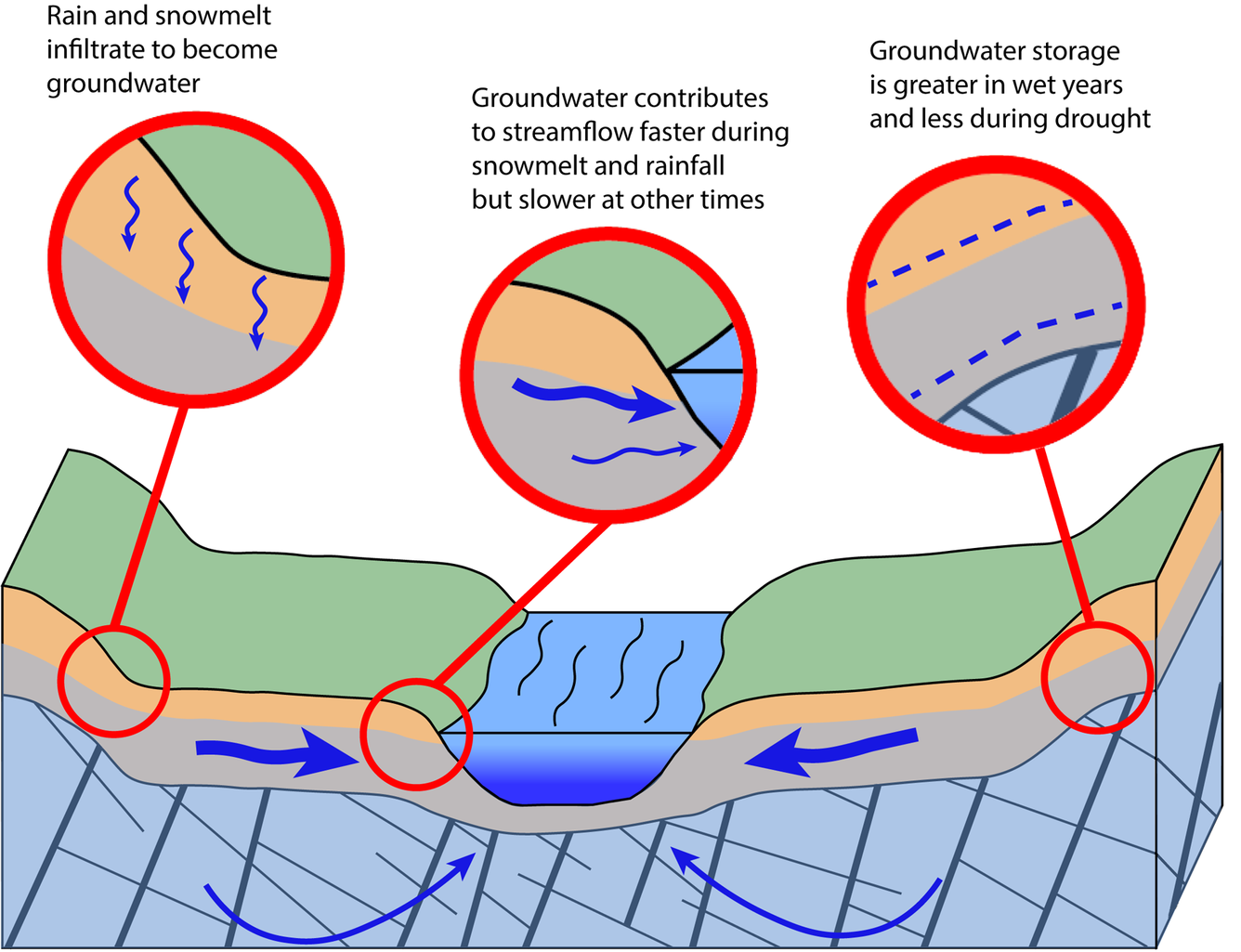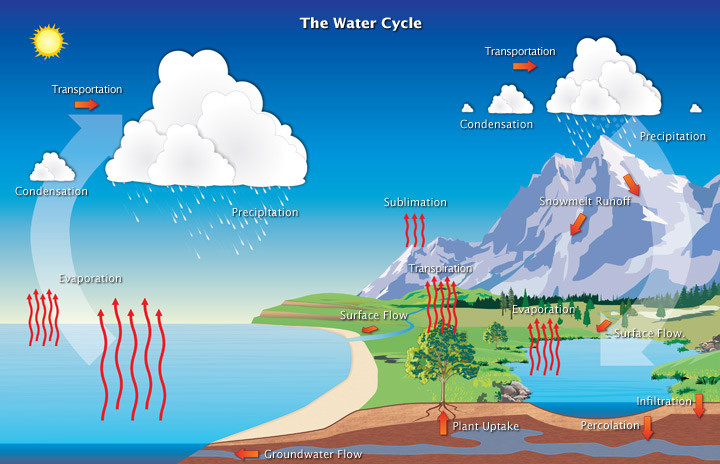IB Syllabus focus:
‘Flows include transpiration, evaporation, condensation, precipitation, runoff, infiltration, percolation, streamflow and groundwater flow. Sublimation is ice → vapour; advection is wind-driven movement of vapour or clouds.’
Water moves continuously through the environment via a series of key flows. These transfers and transformations connect the hydrological cycle, shaping availability, distribution, and ecological balance across systems.
The Importance of Water Flows
The hydrological cycle relies on the dynamic movement of water between stores such as oceans, glaciers, groundwater, and the atmosphere. These flows redistribute water spatially and temporally, influencing ecosystems, climate regulation, and human activities. Understanding their mechanisms is essential for assessing sustainability and environmental impacts.
Evaporation and Transpiration
Evaporation
Evaporation transfers water from liquid to vapour, driven by solar energy. It removes water from oceans, lakes, rivers, and soil, contributing significant moisture to the atmosphere.
Evaporation: The process by which liquid water is converted into water vapour and enters the atmosphere, driven primarily by solar radiation.
Transpiration
Transpiration is water loss from plants through stomata. Together, evaporation and transpiration form evapotranspiration, a major pathway returning terrestrial water to the atmosphere.
Transpiration: The release of water vapour from plant leaves through small pores called stomata.
Condensation and Precipitation
Condensation
Condensation occurs when water vapour cools and forms liquid droplets, creating clouds and fog. It releases latent heat, influencing local and global climate systems.
Condensation: The process where water vapour changes into liquid droplets when air is cooled to its dew point.
Precipitation
Precipitation delivers atmospheric water back to the Earth’s surface in forms such as rain, snow, sleet, or hail. It replenishes terrestrial and aquatic stores.
Precipitation: Any form of water, liquid or solid, that falls from the atmosphere to the Earth’s surface.
Surface and Subsurface Flows
Runoff
Runoff is surface water flowing over land into rivers, lakes, and seas. It links precipitation with aquatic systems and can intensify with land-use change.
Runoff: The movement of water over the Earth’s surface, often into streams and rivers, following rainfall or snowmelt.
Infiltration and Percolation
Infiltration is the entry of water into soil from the surface.
Percolation refers to water movement deeper through soil and porous rock into aquifers.
These flows maintain groundwater stores and regulate soil moisture.
Infiltration: The process by which water enters the soil surface after precipitation.
Percolation: The downward movement of water through soil and porous rock layers into groundwater stores.
Infiltration transfers water from the surface to the unsaturated zone; percolation moves it to groundwater, which can discharge as baseflow sustaining streamflow between storms.

Conceptual diagram showing rainfall/snowmelt infiltrating to recharge groundwater, then groundwater flow discharging to a stream as baseflow. Insets illustrate faster and slower subsurface pathways and how storage varies between wet years and drought; the storage detail is additional context beyond syllabus requirements. Source.
Streamflow and Groundwater Flow
Streamflow
Streamflow represents water moving through river channels. It connects upland catchments to oceans, transporting nutrients, sediments, and dissolved gases.
Streamflow: The movement of water within river channels, contributing to the drainage of a catchment.
Groundwater Flow
Groundwater flow moves water slowly through aquifers, often supplying springs and baseflow to rivers. It is vital for sustaining flows during dry periods.
Groundwater Flow: The lateral or vertical movement of water through aquifers beneath the Earth’s surface.
Sublimation and Advection
Sublimation
Sublimation bypasses the liquid phase as ice or snow directly converts to water vapour. It is most significant in cold regions with high solar radiation.
Sublimation: The process where solid water (ice or snow) changes directly into vapour without passing through the liquid state.
Advection
Advection is the horizontal transport of water vapour or clouds by wind, redistributing atmospheric moisture across regions.
Advection: The horizontal movement of water vapour or clouds in the atmosphere, driven by wind.
Flows include transpiration, evaporation, condensation, precipitation, runoff, infiltration, percolation, streamflow and groundwater flow. Sublimation is ice → vapour; advection is wind-driven movement of vapour or clouds.

Diagram of the water cycle highlighting energy-driven phase changes (evaporation, transpiration, sublimation) and gravity-driven pathways (runoff, infiltration, percolation, groundwater flow). Note the labelled “Transportation,” which corresponds to advection—the wind-driven movement of vapour or clouds. This version also shows snowmelt runoff and plant uptake; these are useful context but not required by the syllabus. Source.
Interconnections of Flows
These flows do not act in isolation but are interconnected components of a global system:
Evaporation, transpiration, and sublimation feed atmospheric vapour.
Condensation and advection redistribute moisture.
Precipitation, infiltration, percolation, runoff, streamflow, and groundwater flow return water to surface and subsurface stores.
Together, they illustrate the cyclical, dynamic, and closed nature of the hydrological system.
FAQ
Higher temperatures increase the kinetic energy of water molecules, which speeds up evaporation from water bodies and soils.
For transpiration, warmer conditions open stomata more frequently and intensify water loss from plants. However, extreme heat may cause stomata to close, reducing transpiration to conserve water.
Sandy soils: Large pore spaces allow rapid infiltration and high percolation rates.
Clay soils: Small pore spaces slow infiltration and reduce percolation.
Loam soils: Balanced texture provides moderate infiltration and good percolation, supporting groundwater recharge.
Soil compaction from agriculture or construction further decreases infiltration, leading to increased surface runoff.
Advection transports water vapour horizontally across long distances, connecting otherwise separate hydrological systems.
Moisture carried by winds can supply rainfall to areas far from oceans or lakes, supporting agriculture and ecosystems in inland regions. This process also explains why weather patterns can shift rapidly when wind direction changes.
Dense vegetation increases interception, slowing water movement and reducing surface runoff. Root systems also enhance soil infiltration.
In contrast, deforested or urbanised land promotes faster runoff by removing barriers and increasing impermeable surfaces, which can intensify flood risk and reduce groundwater recharge.
Groundwater flow sustains rivers and wetlands during dry periods by providing baseflow.
This steady release helps maintain aquatic habitats, supports biodiversity, and stabilises water quality. Without consistent groundwater contributions, many streams would dry up seasonally, leading to habitat loss and reduced ecosystem resilience.
Practice Questions
Question 1 (2 marks)
Define the following terms as used in the hydrological cycle:
(a) Transpiration
(b) Sublimation
Mark scheme:
(a) Transpiration: Release of water vapour from plant leaves through stomata. (1 mark)
(b) Sublimation: Direct change of solid water (ice or snow) into vapour without passing through the liquid state. (1 mark)
Question 2 (5 marks)
Explain how land use changes such as deforestation and urbanisation can alter the relative importance of flows within the hydrological cycle, with reference to at least three flows.
Mark scheme:
Correct identification of at least three relevant flows: e.g. evaporation, transpiration, runoff, infiltration, percolation, streamflow. (1 mark)
Explanation that deforestation reduces transpiration (less vegetation) and can increase runoff due to decreased canopy interception. (1 mark)
Explanation that urbanisation reduces infiltration and percolation because of impermeable surfaces, increasing surface runoff. (1 mark)
Linking change in flows to greater flood risk or altered groundwater recharge. (1 mark)
Clear, coherent explanation connecting land use change with altered water balance in the system. (1 mark)

